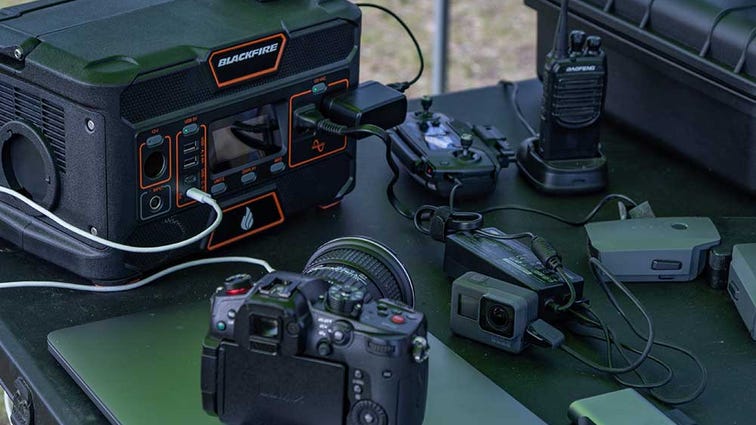Portable power stations are the smaller, lesser-known cousins of generators. They have the port, jack and outlet selection you need to keep your power tools, phone and other electronics charged and running smoothly. These versatile, lunch-box-size power banks can go with you to construction sites, on camping trips or wherever else you need electricity. They’re also useful backup power sources during a power outage when you need to keep your phone on or an essential appliance running. The best portable power station for your particular needs will depend on many factors, but it will probably come down to the cardinal two: power delivery performance and price.
I tested seven portable power stations ranging from a few hundred dollars to over a thousand dollars to compile this list. Two of the models I initially reviewed and recommended — the Klein Tools KTB5 (best midrange) and the Rockpals 300W (best budget) — have been discontinued. I replaced them with newer, similar versions, but these models have not been tested for power delivery and overall performance.
I focused exclusively on rechargeable battery-powered models with the best portable power station performances for their prices, but gas generator models and solar-powered varieties are also available. While each power station provides mobile power in a compact design, each portable generator has a different design and range of features. I put each battery pack through its paces and considered factors such as battery life, wattage, power output, type of charging ports the power station offered (at least one USB port was a must!) and more. Each is more than just an on-the-go phone battery charger or glamping must-have. These power bank performers have wide-ranging uses from building and construction, to staying connected with the office or family to having access to emergency lighting and power wherever you roam, just to name a few.
Keep in mind that the prices I note below for each portable power station may change as retailers introduce sales and other updates. I’ll do my best to check in regularly so they reflect the most recent pricing.
That’s it. Let’s find the best portable power station to suit your needs.

 \n ","topic":"","ttag":"","variant":"","viewguid":"","event":"listicle|image|1","correlationId":"","_destCat":"https:\/\/www.amazon.com\/Jackery-Portable-Explorer-Generator-Emergency\/dp\/B083KBKJ8Q","productName":"Best portable power station overall","formatType":"IMAGE","location":"LIST","position":1,"sku":"","dwLinkTag":"article-body|listicle|image","selector":"#article-body #listicle-43fdef9a-94e9-46de-a2df-071a7fc23678 .itemImage"}}” rel=”noopener nofollow” target=”_blank”>
\n ","topic":"","ttag":"","variant":"","viewguid":"","event":"listicle|image|1","correlationId":"","_destCat":"https:\/\/www.amazon.com\/Jackery-Portable-Explorer-Generator-Emergency\/dp\/B083KBKJ8Q","productName":"Best portable power station overall","formatType":"IMAGE","location":"LIST","position":1,"sku":"","dwLinkTag":"article-body|listicle|image","selector":"#article-body #listicle-43fdef9a-94e9-46de-a2df-071a7fc23678 .itemImage"}}” rel=”noopener nofollow” target=”_blank”>


Megan Wollerton/CNET
The Jackery Explorer 1000 is by far the most well-rounded portable power station of the bunch. At 22 pounds, this powerful generator is fairly compact, especially compared with the 44-pound Ego Nexus model. Despite this Jackery portable power station’s smaller size, it manages to make space for three three-prong outlets, two USB-C ports, two standard USB-A ports and more to use for your power supply and for charging your devices.
Its display is easy to read, too, and it dominated the performance tests, exceeding its expected battery power run time of 3 hours and 2 minutes (with three work lights connected to it) by an average of 8.5 minutes. For an additional $500, you can tack on a portable solar panel pack and use it as a solar generator for solar power when you’re camping.
Fast facts
- Price (Amazon): $999
- Watt-hours: 1,002
- Weight: 22 pounds

 \n ","topic":"","ttag":"","variant":"","viewguid":"","event":"listicle|image|2","correlationId":"","_destCat":"https:\/\/www.bhphotovideo.com\/c\/product\/1641524-REG\/blackfire_pac505_portable_power_pack.html","productName":"Best midrange power station","formatType":"IMAGE","location":"LIST","position":2,"sku":"","dwLinkTag":"article-body|listicle|image","selector":"#article-body #listicle-4c2a7401-7eb7-4614-83e7-b20a58108d39 .itemImage"}}” rel=”noopener nofollow” target=”_blank”>
\n ","topic":"","ttag":"","variant":"","viewguid":"","event":"listicle|image|2","correlationId":"","_destCat":"https:\/\/www.bhphotovideo.com\/c\/product\/1641524-REG\/blackfire_pac505_portable_power_pack.html","productName":"Best midrange power station","formatType":"IMAGE","location":"LIST","position":2,"sku":"","dwLinkTag":"article-body|listicle|image","selector":"#article-body #listicle-4c2a7401-7eb7-4614-83e7-b20a58108d39 .itemImage"}}” rel=”noopener nofollow” target=”_blank”>


Blackfire
When you don’t need something quite as powerful as the Jackery Explorer 1000, look to a midrange portable power station with a roughly 500 watt-hour capacity.
I really liked Klein Tools’ KTB5 for its performance and wide variety of outlets and ports (two three-prong outlets, two USB-C ports and two USB-A ports). That model has since been discontinued. Fortunately, Klein Tools owns the brand Blackfire, which makes a model with similar specs: the Blackfire PAC505.
Note that this product is currently on backorder, and availability is estimated at two to four weeks.
Fast facts
- Price (B&H): $499
- Watt-hours: 505
- Weight: 12.1 pounds

 \n ","topic":"","ttag":"","variant":"","viewguid":"","event":"listicle|image|3","correlationId":"","_destCat":"https:\/\/www.amazon.com\/Rockpals-Portable-Generator-Flashlight-Emergency\/dp\/B07FFNTGZ6","productName":"Best budget power station","formatType":"IMAGE","location":"LIST","position":3,"sku":"","dwLinkTag":"article-body|listicle|image","selector":"#article-body #listicle-f0aae6d5-756f-4a2f-bef2-07b7297c1eb4 .itemImage"}}” rel=”noopener nofollow” target=”_blank”>
\n ","topic":"","ttag":"","variant":"","viewguid":"","event":"listicle|image|3","correlationId":"","_destCat":"https:\/\/www.amazon.com\/Rockpals-Portable-Generator-Flashlight-Emergency\/dp\/B07FFNTGZ6","productName":"Best budget power station","formatType":"IMAGE","location":"LIST","position":3,"sku":"","dwLinkTag":"article-body|listicle|image","selector":"#article-body #listicle-f0aae6d5-756f-4a2f-bef2-07b7297c1eb4 .itemImage"}}” rel=”noopener nofollow” target=”_blank”>


Rockpals
Rockpals replaced its original 300W portable power station with a new model, also called the Rockpals 300.
The original Rockpals 300W I tested was my favorite affordable portable power station. It performed well, was lightweight and had multiple ports and outlet options.
The updated Rockpals 300W has similar specs, including the same 280 watt-hour estimate. But this iteration adds in a USB-C port to provide more charging options. I know $286 isn’t exactly budget, but if it’s anything like the previous-gen model, the new Rockpals 300W is well worth considering.
Fast facts
- Price (Amazon): $286
- Watt-hours: 280
- Weight: 7.7 pounds
Read more: Next-gen rescue vehicles leave ambulances in their dust
Portable power station FAQs
How many years do portable power stations last?
How many years a portable power station last depends on two key factors — how well the product is maintained and how often it’s used.
I reached out to Jackery, Blackfire and Rockpals customer service to ask specifically about the Jackery Explorer 1000, Blackfire PAC505 and the Rockpals 300W I recommend above. All three responded promptly with “about 500 cycles.”
One cycle means using the product from fully charged to zero charge. Therefore, if you use your portable power station several times a week, it might only last a year or two. But if you use it less frequently, it could last for much longer.
What can you run on a portable power station?
Portable power stations are generally designed to power smaller electronic devices and appliances, from phones and table fans to heavy-duty work lights and CPAP machines. Pay attention to the estimated watt-hours each brand provides in its specs to determine which model makes the most sense for what you’d like to power.
If a company says its portable power station has 200 watt-hours, it should be able power a device with a 1-watt output for about 200 hours. I go into more detail on this in the “How we test” section below, but consider the wattage of the device or devices you want to power and then the number of watt-hours your portable power station would need to have.
Can a power station run a refrigerator?
Possibly, depending on the fridge and the portable power station.
For example, this standard LG refrigerator has an estimated annual energy consumption of 608 kilowatt-hours. That works out to 1.67 kilowatt-hours per day, or 1,670 watt-hours per day.
1,670 watt-hours per day works out to just under 70 watt-hours per hour. If you have a short-term power outage and only need to power your fridge, a 200-watt-hour power station could keep it running for nearly three hours. You’d need a power station with higher estimated watt-hours to run your fridge for longer. A mini fridge would last much longer than a larger model.
Always confirm the electrical requirements for your specific fridge and portable power station before trying this, especially the peak/startup watts of your refrigerator.
How we test
Before diving into how I tested these things, here’s a list of the models I looked at. Keep in mind that several of the original models have since been discontinued.
Every company that sells portable power stations provides the expected number of watt-hours its products are supposed to last. For the Goal Zero Yeti 200x, that’s 187 watt-hours; for the Paxcess 300W, it’s 288 watt-hours. The Jackery Explorer 1000 claims 1,002 watt-hours.
That means if you run a device with a 1-watt output on the Yeti 200x, it should last for about 187 hours. You’d get 288 hours from the Paxcess model and a whooping 1,002 hours using the Jackery generator. For reference, a USB-C iPhone charger draws up to 18 watts, a 3-quart Instant Pot draws 700 watts and a standard microwave draws around 600 to 1,200 watts, depending on the model.
Since I didn’t have a 1-watt device to test (wait, are there any 1-watt devices out there?) and because I don’t have over 187 hours to test a single power station, our labs manager, Steve Conaway, devised a clever plan: I’d use 110-watt, 10,000-lumen portable LED work lights (here are the exact ones I used).
For example, if you divide the Yeti 200x’s 187 expected watt-hours by 110 (the number of watts in one of the work lights), you get 1.7. Then my accountant husband helped me convert each decimal into each power station’s expected run time. 1.7 equals an expected run time of 1 hour and 42 minutes from fully charged to zero (when the light turned off).
I plugged a work light into the Goal Zero Yeti 200x, Rockpals 300W and Paxcess 300W. The higher-watt-hour Blackfire PAC500 and Klein Tools KTB5 each ran two work lights, again, to reduce the test time. And the two largest generators, the Jackery Explorer 1000 and the Ego Nexus 3000 PST3042, each ran three work lights per test.
I ran two identical tests with each of the seven power stations to track consistency and rule out any anomalous results. In the end, each one performed pretty close to the expected run time.
Test results
| Price | Watt-hours | Expected run time | Actual average run time | Actual vs. expected run time | Number of lights | |
|---|---|---|---|---|---|---|
| Goal Zero Yeti 200x | $300 | 187 | 1 hour, 42 minutes | 1 hour, 33 minutes | 9 minutes less than expected | 1 |
| Rockpals 300W | $270 | 280 | 2 hours, 33 minutes | 2 hours, 35 minutes, 30 seconds | 2.5 minutes more than expected | 1 |
| Paxcess 300W | $300 | 288 | 2 hours, 37 minutes | 2 hours, 19 minutes | 18 minutes less than expected | 1 |
| Blackfire PAC500 | $500 | 546 | 2 hours, 29 minutes | 2 hours, 19 minutes, 30 seconds | 9.5 minutes less than expected | 2 |
| Klein Tools KTB5 | $500 | 546 | 2 hours, 29 minutes | 2 hours, 27 minutes | 2 minutes less than expected | 2 |
| Jackery Explorer 1000 | $1,000 | 1,002 | 3 hours, 2 minutes | 3 hours, 10 minutes, 30 seconds | 8.5 minutes more than expected | 3 |
| Ego Nexus 3000 PST3042 | $1,200 | 840 | 2 hours, 33 minutes | 2 hours, 14 minutes, 30 seconds | 13.5 minutes less than expected | 3 |
As you can see, all of them got pretty close to the mark, with the Paxcess and the Ego models performing the worst. But only the Jackery and Rockpals power stations consistently ran longer than expected, a definite advantage when you’re logging long hours at a worksite, camping off-grid — or need to keep your phone charged at home following a storm that knocks out your electricity.


